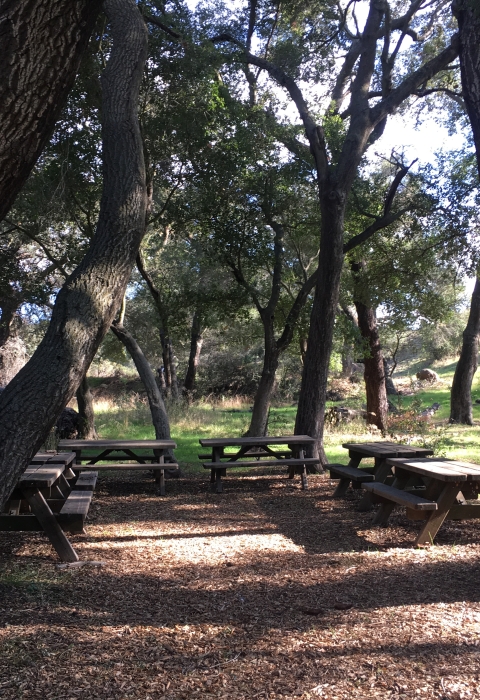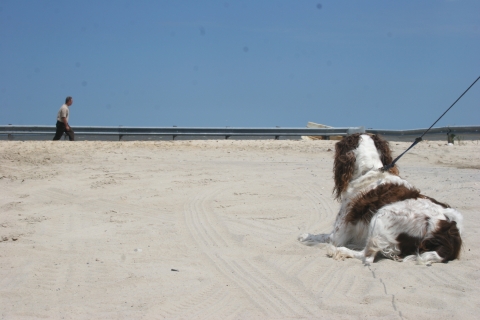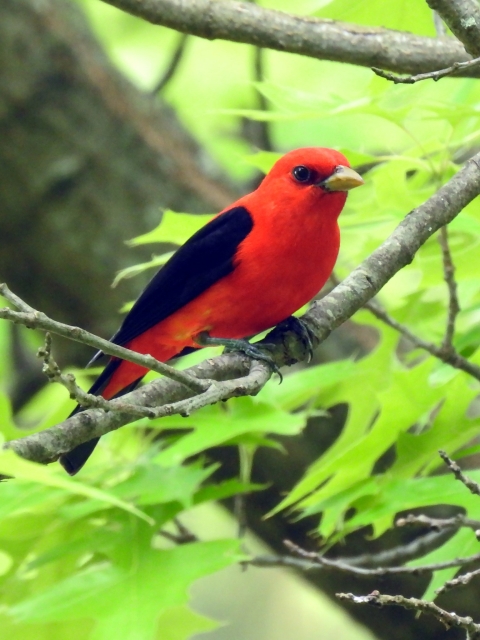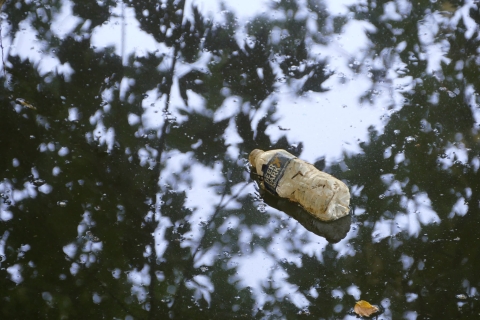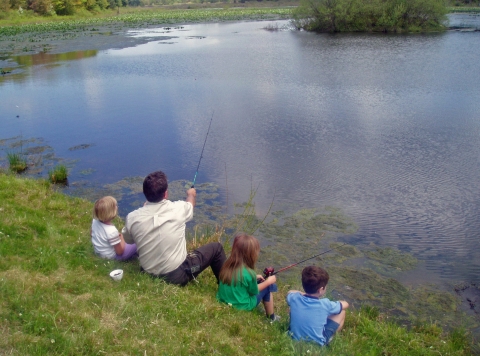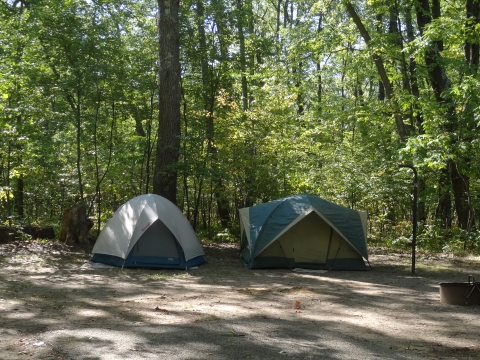The days are getting longer, the weather’s warming up, and blue skies are back. Across the country, family and friends are gathering once again to celebrate the sunshine with spring picnics and barbeques. Picnics provide the perfect opportunity to enjoy the outdoors. By thoughtfully planning your next gathering you can support conservation and help preserve the lands and waters that people and wildlife rely on.
The place to be
For the most environmentally conscious and fiscally frugal, consider hosting in your own backyard. Save on gas and costly travel by enjoying the nature right outside your door. Be mindful, however, that fertilizers, weed killers, and over-mowing all pose threats to wildlife. Leave the leaves. Only mow what you plan to use, and keep the chemicals to a minimum. Your yard will thank you with colorful wildflowers, songbirds, and butterflies.
Looking to expand your view? Stay local by visiting state and town parks. Many of these locations already have accommodations for you and your guests, including restrooms, tables, and grills. Be sure to check park safety restrictions, rules, and regulations before planning your picnic.
Visitors are welcome to enjoy a variety of recreational activities at our national wildlife refuges, including picnics. Before leaving, be sure to look into the designated picnic areas at your local wildlife refuge. To host larger gatherings and events you must first obtain the proper permitting. Refuges are home to an abundance of wildlife. All activities on these public lands are first reviewed and approved with the priority purpose of protecting and conserving the native species that depend on this habitat.
Nothing’s better for the hot summer weather than wading in the waves. Picnicking at the beach means there’s plenty to do and see. Be sure to mind the signs and remain in designated recreation areas. Though you may be tempted to avoid the crowds, area restrictions are put in place for a reason.
Overcrowding along the shore reduces essential nesting habitat for shorebirds like red knots and piping plovers. These birds rely on stretches of undisturbed beach to build their nests and raise their young.
Shorebirds play an important role in coastal ecosystems. Their waste provides nutrients for the vegetation and bacteria that make up wetland habitat. If you’re heading for surf and sand this summer, please remember to share the shore!
Keep your critters off the guest list
Even the most well-behaved pets pose a threat to wildlife. Regardless of their breed, size, age, or gentle nature, cats and dogs are perceived as predators by wild animals. A curious, unattended pet may stumble upon a nest or den, forcing frightened parents to aggressively defend their young. This stress may cause them to avoid feeding, waste time and energy on distraction displays, or even abandon their offspring. If you do bring along your furry friends, be sure to keep them leashed and under the careful watch of a guardian.
What's cooking?
Takeout has grown in popularity for its ease and convenience. Unfortunately, these meals often come pre-packaged in harmful materials like plastics and Styrofoam. For a truly conservation-conscious picnic, make your own meal. Show off your grill-master talents by serving up something fresh like local farm raised meat, fruits, and vegetables. For the cooking challenged, invite your guests for a potluck party.
If you’re grilling burgers and dogs check for the Audubon Society’s grass-fed label. To receive this label, farms must meet Audubon’s standards that require ranchers to improve soil quality and provide much-needed habitat for wildlife.
Now for the moment everyone has been waiting for… dessert! Check your labels for wildlife-friendly coffee and sweets. The Smithsonian Migratory Bird Center has been certifying bird-friendly coffee since 1999. Their standards include a commitment to chemical-free growing that supports a diversity of native shrubs and trees. These regulations help protect the more than 40 species of neotropical migratory songbirds like tanagers, warblers, and orioles, who spend their winters on Latin-American coffee farms.
Sweeten up your treats with a splash of maple syrup. Vermont Audubon partners directly with maple syrup makers to improve their hardwood forests to benefit birds. This includes leaving downed logs, trees, and snags that provide nesting habitat for birds, as well as food for the insects they eat.
Even alcohol can be bird-friendly. There are many breweries across the U.S. who are using beer to better wildlife. By donating their proceeds and raising awareness for conservation efforts, these brew-gooders are helping protect their craft and the planet. Your purchases have an impact, and nothing tastes quite as good as supporting an environmentally conscious company.
Setting the scene
Adopt a “leave-no-trace” philosophy for your picnic. Colorful décor, plastic utensils, and latex balloons will be there long after the last guest leaves. When not disposed of properly, this litter can find its way into run-off and streams, polluting your community’s water. Plants and animals rely on these waterways for hydration and habitat. Even small changes in water conditions can trigger tragic loss in wildlife.
Prioritize hand-held food like sandwiches, fruits, and vegetables. Use washable plates, silverware, and napkins to cut down on plastic use. If disposable dishware is absolutely necessary, opt for compostable alternatives.
Fun and games
Corn hole, horseshoes, and volleyball are all common picnic festivities. Why not change it up a bit? Help out your local community by participating in a litter clean-up. Working alongside your friends and family, you can make a huge difference on your public lands in very little time.
Hone your species identification skills. With a wide variety of online resources and smartphone apps, it’s now easier than ever to learn all about the plants and animals of your neighborhood. Become a citizen scientist by sharing your observations. Apps like iNaturalist harness the power of community to create a robust wildlife database.
Near a public waterway? Many local bait-and-tackle shops offer fishing gear rentals. Check with your state’s fish and wildlife department for more information on licenses and free-fishing opportunities. Not interested in snagging something scaly? Check out local kayak and canoe rentals. These boats are a beginner-friendly way to safely explore wetland wildlife.
Backyard camping is a great option for both kids and adults to explore the wilderness close to home. Pitch a tent, and lay out a sleeping bag. Backyard camping allows you to experience the great outdoors without foregoing creature comforts. Ask guests to bring along their own tents, and keep the party going late into the night.
When darkness falls, you might be tempted to light up the sky with spectacular firework shows. Unfortunately, wildlife might not be as dazzled. The abrupt light and sound is seen as a threat to nesting bald eagles, ospreys, great blue herons, and other birds. The shock of these explosions startles all kinds of wildlife, forcing them to flee into roadways or buildings. The stress may even cause new parents to abandon their young, leaving them vulnerable to predators.
Mishandled fireworks are a fire-safety hazard and have the potential to start wildfires. Protect yourself and wildlife by choosing instead to attend any number of large fireworks displays in cities and towns across the country. Laws help mitigate potential wildlife disturbances at these events, keeping both you and wildlife safe from harm.
This summer, throw a conservation celebration. Planning ahead can help make sure the only thing your picnic leaves behind are great memories.
